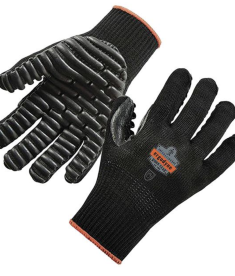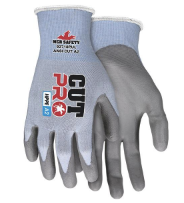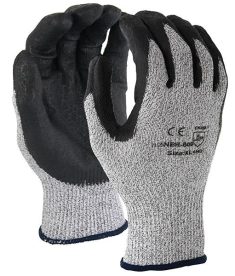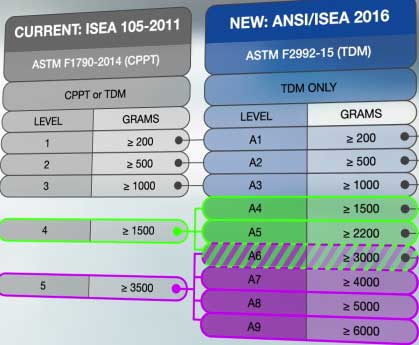New ANSI 105-2016 Cut Level Standards
Workplace Safety – All Hands on Deck
When considering workplace safety in construction, manufacturing, logistics, and other industries where manual labor is performed, among the most common matters that need to be addressed by employers and workers is protecting workers’ hands from injury. Statistics about non-fatal injuries documented for labor employees show that more than 20% of injuries that cause lost time involve hand injuries, which makes sense considering that humans naturally tend to use their hands to accomplish the significant majority of work that is done. That’s just how we’re configured.
So how do we make sure our hands, the precious tools we use to do so many amazing things, are protected from accidents and injuries? ANSI cut level standards play an important role in facilitating interactions between workers, employers, and the government that improve safety
Purchase Anti-Vibration Gloves
-
Product on sale
 Ergodyne ProFlex 9003 Certified Lightweight Anti-Vibration Gloves (X-Large)Original price was: $43.99.$38.99Current price is: $38.99.
Ergodyne ProFlex 9003 Certified Lightweight Anti-Vibration Gloves (X-Large)Original price was: $43.99.$38.99Current price is: $38.99. -
Product on sale
 Ergodyne ProFlex 9003 Certified Lightweight Anti-Vibration Gloves (Large)Original price was: $43.99.$38.99Current price is: $38.99.
Ergodyne ProFlex 9003 Certified Lightweight Anti-Vibration Gloves (Large)Original price was: $43.99.$38.99Current price is: $38.99. -
Product on sale
 Ergodyne ProFlex 9003 Certified Lightweight Anti-Vibration Gloves (Medium)Original price was: $43.99.$38.99Current price is: $38.99.
Ergodyne ProFlex 9003 Certified Lightweight Anti-Vibration Gloves (Medium)Original price was: $43.99.$38.99Current price is: $38.99.
ANSI’s Role As A Standard Setter
ANSI, the American National Standards Institute, is the non-profit standards organization most recognized for its role in setting US standards for products, processes, and other elements of American society. ANSI membership represents 125,000 companies and over 3.5 million professionals, the collective knowledge of which group contributes to a standard of living that the rest of the United States and the rest of the world enjoy.
ANSI regularly rolls out new standards for workplace safety. Their standards reflect the feedback ANSI experts have for the respective industries they serve based upon constantly evolving scenarios. Each new published standard represents the most recent expert opinion about how things should be done.
Old ANSI Recommendation for Hand Safety and Cut Standards
Regarding protecting hands from work injuries, ANSI’s latest 2016 publications include the 2016 ANSI Cut Level Standard, which informs the public about rating the capability of gloves to prevent potential accidents and injuries that tend to occur in various work environments. These ratings allow employers and their workers to make intelligent choices and purchase gloves that protect their hands sufficiently based upon identified risk exposure for their respective work tasks.
Previous to the release of the 2016 ANSI Cut Level Standard, the ANSI standard for material used for making gloves used a 0 to 5 scale, with a rating of 4 spanning the widest variation, going from 1500 to 3499 grams of weight needed to cut the material with a 1-inch blade travel. Testing for cut resistance is done using a test method referred to as ASTM F 1790, in which the material’s cut resistance to various loads (described in grams of force) is determined. Until 2015, that scale broke down as follows:
Level 0 – less than 200 grams
Level 1: 200 – 499 grams
Level 2: 500 – 999 grams
Level 3: 1000 – 1499 grams
Level 4: 1500 – 3499 grams
Level 5: 3500+ grams
As you can see, intervals 4 and 5 cover a much wider range than the other rating levels. As material science has developed, and more precision has been inserted in the construction of glove material, those intervals have been expanded to match glove material with usefulness for specific tasks by creating a new, more robust set of criteria.
Purchase Cut Resistant Gloves
-
Product on sale
 MCR Safety® Cut Pro™ Gloves w/ Blue Hypermax™ Shell – LargeOriginal price was: $76.99.$69.99Current price is: $69.99.
MCR Safety® Cut Pro™ Gloves w/ Blue Hypermax™ Shell – LargeOriginal price was: $76.99.$69.99Current price is: $69.99. -
Product on sale
 MCR Safety® Cut Pro™ Gloves w/ Blue Hypermax™ Shell-MediumOriginal price was: $76.99.$69.99Current price is: $69.99.
MCR Safety® Cut Pro™ Gloves w/ Blue Hypermax™ Shell-MediumOriginal price was: $76.99.$69.99Current price is: $69.99. -
Product on sale
 ANSI Level 3 Cut-Resistant Nitrile Coated Work Gloves – XL, 1 DozenOriginal price was: $99.99.$69.99Current price is: $69.99.
ANSI Level 3 Cut-Resistant Nitrile Coated Work Gloves – XL, 1 DozenOriginal price was: $99.99.$69.99Current price is: $69.99. -
Product on sale
 ANSI Level 3 Cut-Resistant Nitrile Coated Work Gloves – Small, 1 DozenOriginal price was: $99.99.$69.99Current price is: $69.99.
ANSI Level 3 Cut-Resistant Nitrile Coated Work Gloves – Small, 1 DozenOriginal price was: $99.99.$69.99Current price is: $69.99.
The New ANSI 105-2016 Cut Level Standard
The most recent ANSI standard, ANSI 105-2016 updated the ISEA-2011 standard as shown in the charts below. Major differences in the 2016 standard include:
- The testing mechanism used to determine cut resistance according to the new standard is the ASTM F2992-15 (TDM) standardized test, which uses a Tomodynamometer to perform repeatable cut resistance testing.
- The updated ANSI/ISEA classifications include an ‘A’ next to the level number to more clearly identify the new standard.
- Levels 4 and 5 have been redefined to cover 6 different resistant levels, as identified in the chart below.
Cut Levels and Common Work Glove Uses
The ultimate value provided by the ANSI 105 standard is the ability for employers and workers to confidently select gloves that match the work they will be performing. For extreme cut hazards, such as heavy metal stamping, plate glass handling, and some pulp and paper applications, workers should wear gloves that are rated higher on the ANSI cut level standard chart, somewhere between 5-9. For less hazardous activities, such as light metal stamping and light-duty glass handling environments, workers can get away with ANSI cut level 3 gloves, which are normally less expensive than the more technical gloves that meet the higher, cut level standards. For work applications such as automotive maintenance and, paper assembly, and material handling, ANSI cut level 1 gloves, which tend to be even less expensive than gloves rated at higher ANSI cut levels.
Using the ANSI 105-2016 Cut Level Standards, employers can outfit their personnel with gloves that most economically provide adequate protection for their hands. This standard contributes to safety in the workplace and addresses protecting workers’ hands, one of the most vulnerable aspects of jobs that involve manual labor.

